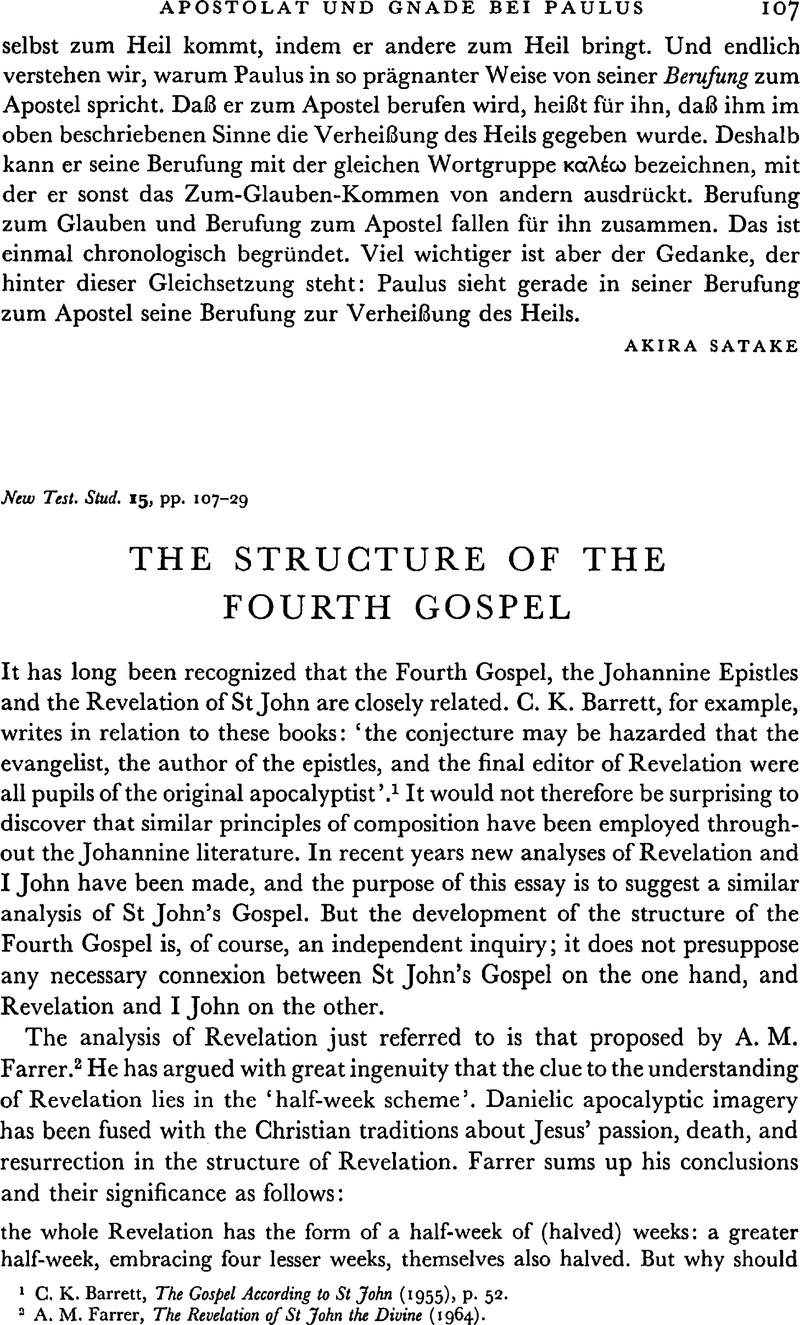Article contents
The Structure of the Fourth Gospel
Published online by Cambridge University Press: 05 February 2009
Abstract

- Type
- Short Studies
- Information
- Copyright
- Copyright © Cambridge University Press 1968
References
page 107 note 1 Barrett, C. K., The Gospel According to St John (1955), p. 52Google Scholar.
page 107 note 2 Farrer, A. M., The Revelation of St John the Divine (1964)Google Scholar.
page 108 note 1 Farrer, , op. cit. pp. 11 fGoogle Scholar.
page 108 note 2 O'Neill, J. C., The Puzzle of I John (1966)Google Scholar.
page 108 note 3 Dodd, C. H., The Interpretation of the Fourth Gospel (1953)Google Scholar.
page 108 note 4 Barrett, , op. cit. p. 11Google Scholar.
page 108 note 5 Bernard, J. H., The Gospel according to St John (1928), p. cxxxviiiGoogle Scholar.
page 109 note 1 Barrett, , op. cit. p. 126Google Scholar.
page 109 note 2 Lightfoot, R. H., St John's Gospel (1956), p. 78Google Scholar.
page 109 note 3 Bernard, , op. cit. pp. xxx–xxxiiiGoogle Scholar.
page 109 note 4 Barrett, , op. cit. pp. 11–14Google Scholar.
page 110 note 1 Op. cit. pp. 11–21Google Scholar.
page 110 note 2 Barrett, , op. cit. p. 18Google Scholar.
page 110 note 3 Op. cit. pp. 125 fGoogle Scholar.
page 111 note 1 Jeremias, J., The Central Message of the N.T. (1965), chapter 4Google Scholar.
page 111 note 2 See Dodd, C. H., Historical Tradition in the Fourth Gospel (1963), pp. 248 fGoogle Scholar.
page 112 note 1 Op. cit. p. 12Google Scholar.
page 112 note 2 Dodd, , op. cit. pp. 288–301Google Scholar.
page 112 note 3 Luke, i. 36Google Scholar.
page 112 note 4 It may also be noted that there is a linear progression of witness among the disciples themselves: Rabbi (i. 38) refers to a contemporary order of Jewish teachers; Messiah (i. 41) picks one particular form of Jewish eschatological expectation, while Fulfiller of the Law and Prophets (i. 45) broadens this Jewish hope to include the whole pre-Christian era; finally Rabbi, Son of God, King of Israel (i. 49), grounds Jesus' status in his eternal relation to the Father-a category which supersedes Messianism.
page 113 note 1 See Farrer, , op. cit. p. 9Google Scholar.
page 113 note 2 Cf. Barrett's, interpretation, op. cit. p. 158Google Scholar.
page 114 note 1 Barrett, , op. cit. p. 233Google Scholar.
page 114 note 2 See above, p. 112.
page 115 note 1 Cf. Lightfoot, op. cit. p. 209Google Scholar.
page 115 note 2 See above, p. 114.
page 115 note 3 It may be that the witness of scripture is found only in xii. 37–43; xii. 44–50 would then be a free summary of Christ's offer, written by the author. x. 24 f. and xii. 27 f. are based on traditional stories of Jesus' trial before the Sanhedrin and his visit to Gethsemane respectively. Perhaps St John has deliberately removed these from his Passion story (cf. the Synoptists) to serve his theological scheme. See Dodd, C. H., op. cit. pp. 69–71, 91 fGoogle Scholar.
page 115 note 4 See above, p. 117
page 115 note 5 Barrett, , op. cit. p. 222Google Scholar.
page 116 note 1 Barrett, , op. cit. p. 304Google Scholar. For a fuller discussion see Lightfoot, op. cit. pp. 205 f. and 209 fGoogle Scholar.
page 116 note 2 See further p. 123 below.
page 116 note 3 John, I ii. 20, 27Google Scholar.
page 117 note 1 P. 114 above.
page 118 note 1 P. 113 above.
page 118 note 2 Lightfoot, , op. cit. p. 16Google Scholar.
page 119 note 1 See above, p. 111.
page 120 note 1 Lightfoot, , op. cit. p. 280Google Scholar.
page 121 note 1 Farrer, , op. cit. pp. 7 ffGoogle Scholar.
page 121 note 2 Farrer, , op. cit. p. 10. See also pp. 83–6Google Scholar.
page 122 note 1 See above, p. 114.
page 123 note 1 See above, p. 116.
page 123 note 2 Cf. Lightfoot, op. cit. p. 17Google Scholar, who suggests a link between x. 40–xi. 53 and i. 19–28.
page 123 note 3 Jeremias, , op. cit. p. 76Google Scholar.
page 124 note 1 Exod. xii. 22.
page 124 note 2 Exod. xii. 10, 46; Num. ix. 12.
page 124 note 3 P. 116
page 124 note 4 Barrett, , op. cit. p. 158. See also p. 113 aboveGoogle Scholar.
page 124 note 5 Cf. Lightfoot, op. cit. p. 251Google Scholar; but note Barrett's, comment, op. cit. p. 351Google Scholar.
page 125 note 1 This theme is further developed in xii. 27–36.
page 125 note 2 Barrett, , op. cit. p. 11Google Scholar. In particular, the verses on food and the food which is the doing of God's will (iv. 31–4) form a direct link with vi. 35–40; the latter section, interestingly, has a reference back to chapter iv in the words of vi. 35: ‘He who believes in me shall never thirst’.
page 125 note 3 Cf. Cullmann, O., Early Christian Worship (1953), pp. 80–4Google Scholar.
page 125 note 4 See above, p. 114.
page 127 note 1 Cullmann, , op. cit. p. 59Google Scholar.
page 127 note 2 Lightfoot, , op. cit. p. 20Google Scholar.
page 128 note 1 Bultmann, R., Theology of the New Testament, § 47. 4Google Scholar.
page 128 note 2 Early Christian Worship, Part II.
page 128 note 3 Cf. ‘The problem set by St John's method here is usually explained by his unwillingness to disclose to non-Christian readers of his book the origin and ground of’ the eucharist—and similarly of the sacrament of baptism (Lightfoot, R. H., op. cit. p. 262 n. 1.)Google Scholar.
- 1
- Cited by




